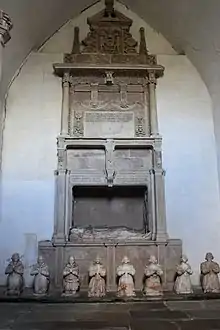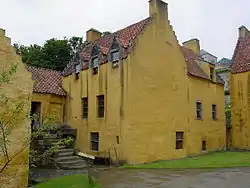George Bruce of Carnock
Sir George Bruce of Carnock (c. 1550 – 1625) was a Scottish merchant and engineer.

Family
He was the brother of Edward Bruce (1548-1610), sons of Sir Edward Bruce of Blairhall, Clackmannanshire [later in Fife], by Alison, sister of Robert Reid, Bishop of Orkney, both children of William Reid of Aikenhead, Clackmannanshire. Edward Bruce jnr., was in 1601/2 created Lord Bruce of Kinloss.[1][2]
Coal mining

Bruce was an innovator in coal mining techniques, introducing undersea mining into the Upper Hirst seam with use of new drainage technology.[3] These innovations attracted much interest, including a visit from King James VI in 1617. Sir George Bruce invited him to visit one of his mines which tunnelled down beneath the sea bed. James ventured into the tunnel which went far out into the Firth of Forth and found himself at a shaft point where the coal was loaded onto the ships. Alarmed to find himself surrounded by water at the top of the shaft, James accused Sir George of an attempt on his life and declared that the whole affair was an act of treason. It was only when George Bruce pointed out the rowing boat and explained that one could either use that or return by the tunnel from whence they came that James relaxed again - and took the option of the boat journey.[4]
Shipping and fishing
Bruce's factor at Helsingør in Denmark was Frederick Lyall, or Leyell, who managed his exports of salt.[5] Lyall was involved in buying a jewel given by the Earl Marischal to Anne of Denmark at her proxy marriage to James VI.[6]
Bruce imported Spanish wine. In 1597 George Bruce was involved in a lengthy legal case involving one of his ships heard in London. The Bruce, a ship he owned, coming from Ferrol encountered the Julian of London and a ship of Southampton, and two pinnaces. The Julian shot at the Scottish ship to bring it to. The English ships were overloaded with men captured from Spanish ships, and 52 men, possibly enslaved Africans and Portuguese sailors were transferred to the Bruce. The Bruce then sailed to Portugal, intending to put the new passengers ashore. A week later an English Man-of-war took the Bruce as a prize, its master, whose name was "Busbrig", thinking it to be a Spanish ship because of the number of captives. Although the ship was restored to Bruce, his original cargo of Spanish wine was lost, drunk by the Portuguese captives or spoilt. When the ship returned to Leith the Provost of Edinburgh, Alexander Home of North Berwick, and the English diplomat Robert Bowes took witness statements from the crew.[7]
Bruce claimed in the London Admiralty Court for the value of the wine from John Clerk, owner of the Julian.[8] Bruce's brother, Edward Bruce, then ambassador in London urged the lawyer Julius Caesar to help, but he thought the details of the case were unclear and not yet fit for hearing on 21 April 1598 because the other English captain involved, John Newton of the Spanish Company (a trader with the Barbary Coast),[9] had not been questioned.[10] In September James VI instructed the diplomat David Foulis to discuss the case with Queen Elizabeth and Sir Robert Cecil. The fate of the Portuguese and Africans aboard the Bruce was not recorded.[11]
In 1599 James VI wrote to Christian IV of Denmark seeking permission for Bruce to fish in Iceland waters, with boats crewed with English sailors for the next ten years, after Christian IV had forbidden English fleets to fish in his territories, following Niels Krag's diplomatic mission to England. Christian had declared an eight-mile or two-league broad closed-sea or mare clausum around Iceland.[12][13]
Culross Palace

Between 1597 and 1611,[4] Bruce built a mansion house in Culross, using materials from his foreign trading. This building has subsequently become known as Culross Palace. He lavishly decorated the palace and the stunning painted ceilings with emblems, other ornate features and panelling can still be seen. Culross Palace is now under the care of the National Trust for Scotland and has been restored and conserved in its 17th-century splendour.[14] The palace building, which had faded to a white wash has been restored to its original yellow-orange harled exterior. The courtyard path and the garden have also been remodelled, with the garden now full of vegetables, herbs and plants, growing as they would have done in the 17th century.[15]
%252C_Culross_Abbey.JPG.webp)
Death
Bruce died on 6 May 1625 and was buried in Culross Abbey (now used as the parish church of Culross and Torryburn). His outstanding memorial (in the north chapel) has himself lying with his wife whilst his eight children, three sons and five daughters, pray, facing outward at the base as half-size figures.
Marriages and family
George married Margaret Primrose, only daughter of Archibald Primrose of Burnbrae (a property of [[Culross Abbey), Writer, whose son, James, was Principal Clerk to the Privy Council. His second wife was Euphame Primrose, a daughter of David Primnrose who lived in Culross.[16] His children included:
- George Bruce, 2nd of Carnock (d. 1643), who married Mary Preston, daughter of John Preston of Valleyfield, and was the father of the Earl of Kincardine
- Robert Bruce of Broomhall (d. 1652), who married Helen Skene, a granddaughter of the diplomat John Skene
- Anne Bruce, who married James Arnot of Fernie
- Christian Bruce, who married (1) Robert Colville, Master of Colville, son of James Colville of Easter Wemyss and Isobel Ruthven, and (2) Laurence Mercer of Aldie
- Magdalene Bruce, who married John Erskine of Balgownie
- Nicholas Bruce (d. 1670), who married (1) John Morrison of Dairsie, and (2) John Dick of Braid, son of William Dick of Braid
- Margaret Bruce (d. 1652), who married Francis Nicholls, an English lawyer
Legacy
In 2015 he was inducted into the Scottish Engineering Hall of Fame.[17]
References
- The Peerage of Scotland published by Peter Brown, Edinburgh, 1834, p.120.
- The Complete Peerage by G.E.Cockayne, edited by the Hon. Vicary Gibbs, vol.ii, London, 1912, p.250.
- "Papers on Mining in Scotland, 18th and 19th centuries". Archives Hub. Archived from the original on 1 August 2012. Retrieved 17 October 2008.
- "Culross". BBC. Retrieved 17 October 2008., Robert Chambers, Domestic Annals of Scotland, vol. i, (1858), 481, citing Forsyth's Beauties of Scotland
- Marguerite Wood, Extracts from the Burgh Records of Edinburgh: 1589-1603, vol. 6 (Edinburgh, 1927), p. 9.
- Miles Kerr-Peterson & Michael Pearce, 'James VI's English Subsidy and Danish Dowry Accounts', Scottish History Society Miscellany XVI (Woodbridge, 2020), p. 26.
- John Duncan Mackie, Calendar State Papers Scotland: 1597-1603, vol. 13 (Edinburgh, 1969), p. 309.
- Calendar State Papers Scotland: 1597-1603, vol. 13 (Edinburgh, 1969), pp. 186-7.
- Mary Doreen Wainwright & James Douglas Pearson, Guide to Manuscripts and Documents in the British Isles Relating to the Middle East and North Africa (Oxford, 1980), p. 396.
- John Duncan Mackie, Calendar State Papers Scotland: 1597-1603, vol. 13 (Edinburgh, 1969), pp. 194-5.
- John Duncan Mackie, Calendar State Papers Scotland: 1597-1603, vol. 13 (Edinburgh, 1969), pp. 297, 309, 343, 345-7.
- William Dunn Macray, Appendix to the 47th Report of the Deputy Keeper of Public Records (London, 1886), p. 40
- Thomas Rymer,Foedera, vol. 16 (London, 1715), pp. 350-35: HMC Salisbury Hatfield, vol. 14 (London, 1923), pp. 84-5.
- "Property Details for Culross". National Trust for Scotland. Archived from the original on 27 September 2011. Retrieved 17 October 2008.
- "Listed Building Report". Historic Scotland. 12 January 1972. Retrieved 17 October 2008.
- Alexander Nisbet, A System of Heraldry, vol. 1 (Edinburgh, 1722), p. 372.
- http://engineeringhalloffame.org/ accessed 4 October 2015
External links
- Sir George Bruce's tombstone
- 'SCOTTISH COMMERCIAL CONTACTS WITH THE IBERIAN WORLD, 1581-1730', Claire McLoughlin, University of St Andrews,PhD thesis, pp. 72-3 for the shipping case